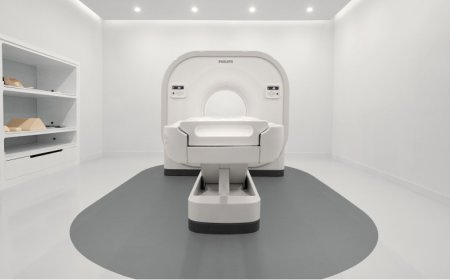Exploring the Future of Filmmaking: Virtual Production and the Rise of Studios Like Infinite Reality Studio
The filmmaking industry has undergone a seismic shift in recent years, driven by technological advancements that have redefined how stories are told on screen. At the forefront of this revolution is virtual production, a groundbreaking approach that blends physical and digital filmmaking techniques to create immersive, photorealistic worlds in real time.

The filmmaking industry has undergone a seismic shift in recent years, driven by technological advancements that have redefined how stories are told on screen. At the forefront of this revolution is virtual production, a groundbreaking approach that blends physical and digital filmmaking techniques to create immersive, photorealistic worlds in real time. This guest post dives into the essence of virtual production, its transformative impact on the entertainment industry, and how studios like Infinite Studio are leveraging this technology to push creative boundaries.
What is Virtual Production?
Virtual production is a modern filmmaking technique that integrates real-time technologies, such as game engines, LED walls, motion capture, and augmented reality, with traditional production methods. Unlike conventional filmmaking, which follows a linear process of pre-production, production, and post-production, virtual production allows filmmakers to visualize and manipulate digital environments during the shooting process. This enables directors, cinematographers, and actors to interact with virtual sets and visual effects (VFX) in real time, reducing the need for extensive post-production work and offering unprecedented creative flexibility.
At its core, virtual production combines several key elements:
-
Real-Time Rendering: Game engines like Unreal Engine and Unity power virtual production by rendering photorealistic 3D environments instantly, allowing filmmakers to see the final look of a scene as its being shot.
-
LED Walls (The Volume): Massive LED screens display dynamic, high-resolution virtual backgrounds that replace traditional green screens, providing realistic lighting and reflections on actors and physical sets.
-
Camera Tracking and Motion Capture: Advanced tracking systems, such as Mo-Sys StarTracker or Antilatency, synchronize camera movements with virtual environments, ensuring accurate perspective and parallax effects.
-
Previsualization (Previs): Filmmakers can create rough CGI assets and virtual sets before shooting, enabling early creative decisions and reducing costly reshoots.
-
In-Camera Visual Effects (ICVFX): Virtual production captures VFX directly in-camera, minimizing the need for compositing in post-production and creating a more natural integration of physical and digital elements.
This approach has revolutionized filmmaking by breaking down barriers between pre-production and the final output, allowing for faster iterations, cost savings, and enhanced creative control. High-profile projects like Disneys The Mandalorian and Avatar: The financire Way of Water have showcased the power of virtual production, making it a staple in modern filmmaking.
The Rise of Virtual Production Studios
The rapid adoption of virtual production has led to the emergence of specialized studios equipped with cutting-edge technology to meet the growing demand for immersive content. These studios, often referred to as virtual production studios, provide filmmakers with the tools and expertise needed to create complex, photorealistic environments without leaving the controlled environment of a soundstage. One such studio making waves in the industry is Infinite Reality Studio, a leader in virtual production based in Thailand and Singapore.
Infinite Reality Studio exemplifies how virtual production studios are transforming the filmmaking landscape. By leveraging Unreal Engine and advanced LED wall technology, the studio delivers stunning virtual productions, from concept to final delivery. Their work, including award-winning projects like the Countdown Lights Virtual Concert 2022, demonstrates the potential of virtual production to create immersive experiences for audiences across genres, from television to live events.
Why Virtual Production is a Game-Changer
Virtual production offers several advantages over traditional filmmaking, making it an attractive option for studios, independent filmmakers, and content creators. Here are some key benefits:
1. Cost and Time Efficiency
Traditional filmmaking often requires expensive location shoots, elaborate physical sets, and lengthy post-production processes to add VFX. Virtual production eliminates many of these costs by allowing filmmakers to create and manipulate digital environments in real time. For example, virtual scouting enables directors to explore virtual locations in VR, reducing the need for costly on-site visits. Additionally, ICVFX minimizes post-production time by capturing final-pixel shots directly on set.
2. Creative Freedom and Flexibility
With virtual production, filmmakers can iterate on their vision during the shooting process. Directors can adjust lighting, camera angles, and virtual backgrounds on the fly, seeing the results instantly on LED walls. This real-time feedback loop empowers creatives to experiment and refine their work without the constraints of traditional workflows. For instance, virtual production was used in John Wick: Chapter 3 Parabellum to choreograph complex scenes and design challenging sets virtually.
3. Enhanced Realism and Immersion
LED walls provide realistic lighting and reflections, creating a more immersive experience for actors and crews compared to green screens. This technology allows actors to perform within a tangible environment, improving their performances by providing visual context. The result is a seamless blend of physical and digital elements that enhances the authenticity of the final product.
4. Accessibility for Indie Filmmakers
While virtual production was initially adopted by major studios, advancements in technology have made it more accessible to smaller productions. Affordable tools like green screens, consumer-grade cameras, and open-source game engines allow indie filmmakers to experiment with virtual production on a budget. This democratization of technology is leveling the playing field, enabling independent creators to produce high-quality content that rivals big-budget productions.
5. Sustainability
Virtual production reduces the environmental impact of filmmaking by minimizing travel and physical set construction. By creating virtual environments, studios can replicate locations worldwide without the carbon footprint associated with on-location shoots. This aligns with the industrys growing focus on sustainable production practices.
Infinite Reality Studio: A Case Study in Innovation
Infinite Reality Studio stands out as a pioneer in the virtual production space, particularly in the Asia-Pacific region. Their state-of-the-art facilities and expertise in Unreal Engine enable them to deliver high-quality virtual productions for a variety of applications, including films, TV series, commercials, and live events. The studios holistic approach, from concept development to audience delivery, ensures that clients receive tailored solutions that meet their creative and budgetary needs.
One of Infinite Reality Studios notable achievements is their work on the Countdown Lights Virtual Concert 2022, which won awards at the Asian Academy Creative Awards for Best Music or Dance Programme and Best Visual or Special FX. This project showcased the studios ability to create immersive virtual environments that captivate audiences, blending real-time rendering with live performances to deliver a groundbreaking concert experience.
The studios success is built on its investment in cutting-edge technology, such as LED volumes, motion capture systems, and real-time rendering engines. By integrating these tools with a team of skilled professionals, Infinite Reality Studio provides end-to-end virtual production services, making it a go-to destination for filmmakers seeking innovative storytelling solutions.
The Technology Behind Virtual Production
To fully appreciate the impact of virtual production, its essential to understand the technology that powers it. Heres a closer look at the key components:
LED Walls and Volumes
LED walls, often referred to as The Volume, are large-scale screens that display photorealistic virtual environments. These walls replace green screens, providing dynamic backgrounds that respond to camera movements and lighting changes. For example, the worlds largest virtual production stage, located at Docklands Studios Melbourne, uses LED walls to create expansive, immersive sets.
Game Engines
Game engines like Unreal Engine and Unity are the backbone of virtual production, enabling real-time rendering of complex 3D environments. Unreal Engine 5, with its Nanite and Lumen technologies, allows filmmakers to create lifelike virtual scenes with unprecedented detail and lighting accuracy.
Camera Tracking and Motion Capture
Precision camera tracking systems, such as Mo-Sys StarTracker or Antilatency, ensure that virtual backgrounds align seamlessly with camera movements. Motion capture technology captures actors movements, allowing them to interact with virtual characters or environments in real time.
Virtual Scouting and Previs
Virtual scouting allows filmmakers to explore digital locations in VR, while previs enables the creation of rough CGI assets for planning purposes. These tools help directors visualize scenes early in the process, reducing the risk of costly changes later.
Challenges and Future Outlook
Despite its advantages, virtual production faces challenges, including the high initial cost of equipment and the need for skilled professionals who understand both filmmaking and virtual technologies. The scarcity of trained experts can be a barrier for smaller studios, but as the technology becomes more accessible, training programs and educational resources are emerging to bridge this gap.
Looking ahead, the virtual production market is poised for significant growth. According to industry reports, the market is expected to reach USD 6.65 billion by 2030, driven by advancements in LED walls, motion capture, and AI-driven content creation. As studios like Infinite Reality Studio continue to innovate, virtual production will become an integral part of filmmaking, enabling creators to tell stories in ways that were once unimaginable.
Conclusion
Virtual production is more than just a technological trend; its a paradigm shift that is redefining the art and business of filmmaking. By blending real-time technologies with traditional techniques, virtual production studios like Infinite Reality Studio are empowering filmmakers to create immersive, cost-effective, and sustainable content. As the industry continues to evolve, virtual production will play a central role in shaping the future of storytelling, offering limitless possibilities for creativity and innovation.
Whether youre a seasoned filmmaker or an indie creator, now is the time to explore the potential of virtual production. With studios like Infinite Reality Studio leading the charge, the future of filmmaking is brighterand more immersivethan ever.





















